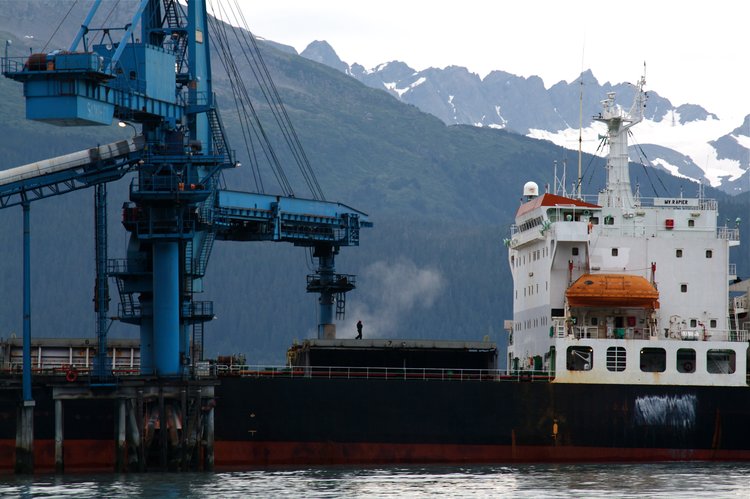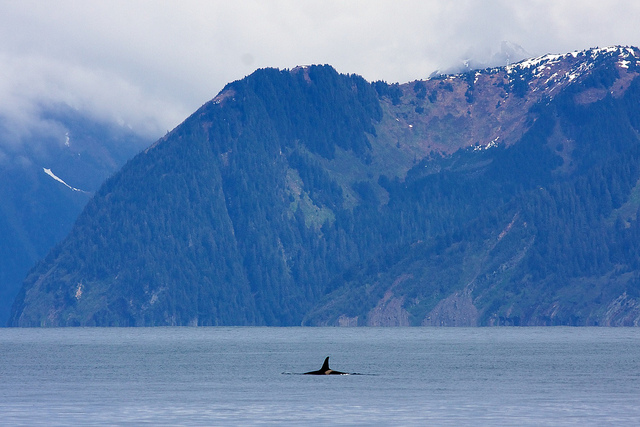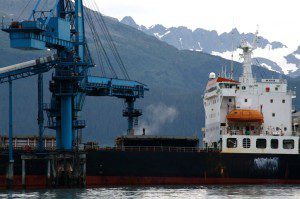
Seward Coal Facility Seeks Permit
Seward residents knew for years that coal was dropping into Resurrection Bay from the Seward Coal Loading Facility. In late 2009, Trustees for Alaska, representing Alaska Community Action on Toxics and the Sierra Club, sent a letter to the owner of the loading facility, Alaska Railroad, and the operator, Aurora Energy Services. The letter, supported by numerous photographs, identified that coal was falling off the Facility’s conveyor system into Resurrection Bay.

Resurrection Bay is home to abundant marine life including orcas also known as killer whales. NPS Photo by Jim Pfeiffenberger.
Under the Clean Water Act, the discharge of pollutants, like coal, into waterbodies requires a permit, even if the discharge is unintended or incidental. The Clean Water Act is clear on that point. The Facility had no permit to dump coal into Resurrection Bay. For years, its operations were polluting Resurrection Bay as it loaded coal ships bound for Asian and South American markets. The Facility does not dispute that coal continues to fall into the Bay. A recent survey of the seafloor below the conveyor found significant amounts of coal piled up below the shiploader.
Back in 2009, we expected the Facility would quickly resolve the matter by doing the logical, legal, and sensible thing and get the permit it needed. The letter didn’t threaten to shut down the Facility. It was simply a matter of getting the right permit, which in turn would require the Facility to control the discharges by taking workable and cost-effective measures.
We were very wrong. Instead of seeking the permit it needed, the Facility choose to fight a long and costly legal battle. After years of litigation, we won. The Ninth Circuit agreed that the Facility is violating the Clean Water Act by discharging coal into the Bay. Even then the Facility took the extraordinary measure of seeking review from the Supreme Court. They lost that battle as well. And now, six years later, they are finally getting the permit we told them they needed in our 2009 letter.
Trustees staff attorney Brian Litmans, who has worked on this case since 2009, commented that “It is unbelievable that a company would fight so hard, and for so long, to avoid following state and federal permitting laws and spend millions in legal fees instead of simply improving the Facility and getting the permit. After losing in court, the Facility is finally seeking the permit it needs.”
On August 5th, the Alaska Department of Environmental Conservation (DEC) came one step closer to resolving this matter by holding a hearing in Seward on the draft permit. “We believe that the current draft permit does not protect the health of this community and the waters of Resurrection Bay, as it does not require any facility improvements to address documented sources of coal pollution from the end of the conveyor or shiploader,” said ACAT representative Jessica Thornton at the hearing. “Threatening Alaskan waters for short-term gain is unacceptable, and the health of this community and the marine waters that we are so dependent on should be a top priority.”
“Alaskans supporting stronger protections for the people of Seward and Resurrection Bay outnumbered Aurora Energy’s testimony three to one,” said Laura Comer with the Sierra Club. “The audience listened as local residents demanded that Aurora Energy make improvements to its coal export facility and stop dumping coal into the Bay”.
Although we believe the permit needs to be stronger than currently drafted, the Facility is finally coming into compliance with the Clean Water Act.
It’s possible the Railroad and Aurora Energy fought so long and hard because they thought we’d give up and drop the case. But, the process of defending Alaska from illegal polluters takes patience and resilience; thankfully, something Trustees for Alaska has in abundance. Instead, Trustees attorneys stuck with our clients to see that this gross violation of the law was brought into compliance. Trustees for Alaska works to protect Alaska’s lands, waters, wildlife, and people—no matter how long it takes.
We expect DEC to issue the permit sometime this fall.
Read other stories on the Seward Coal Loading Facility.



